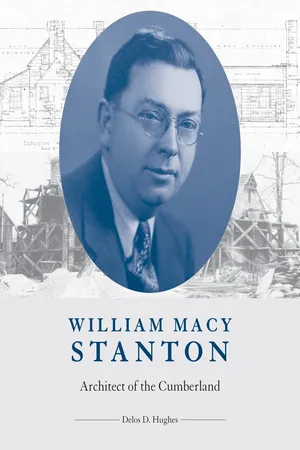
- English
- ePUB (mobile friendly)
- Available on iOS & Android
eBook - ePub
About this book
In 1933, President Franklin Roosevelt's New Deal launched the Tennessee Valley Authority and the Subsistence Homesteads Division to help bring economic relief to families and communities devastated by the Great Depression. With the creation of these new programs came a need for the infrastructure that could support them, and for this, the Roosevelt administration turned to William Macy Stanton.
Born to a Quaker family in Ohio in 1888, Stanton worked as an instructor of drawing and design at the University of Illinois School of Architecture before establishing an independent practice in Philadelphia in the early 1920s. During the Depression, he worked on architectural projects in Tennessee for the TVA—including the town of Norris, where the builders of Norris Dam would live. As the New Deal era dawned, Stanton moved to Crossville to design the proposed Cumberland Homesteads. In addition to this work, Stanton is widely regarded for his hotel designs, including The Lafayette and James Madison Hotels in Atlantic City, as well as his restoration of Quaker meetinghouses.
In this new biography, Delos D. Hughes weaves the story of Stanton's life and career together with the broader historical context of the Great Depression and New Deal initiatives. The book is divided into three parts, exploring Stanton's life and work before, during, and after his involvement with the Cumberland Homesteads; Hughes examines the intersection of architecture and social policy throughout. Rich with historical photographs, Stanton's own architectural drawings, and other original imagery on nearly every page, Hughes's work will delight architectural history enthusiasts and Tennessee history scholars.
Born to a Quaker family in Ohio in 1888, Stanton worked as an instructor of drawing and design at the University of Illinois School of Architecture before establishing an independent practice in Philadelphia in the early 1920s. During the Depression, he worked on architectural projects in Tennessee for the TVA—including the town of Norris, where the builders of Norris Dam would live. As the New Deal era dawned, Stanton moved to Crossville to design the proposed Cumberland Homesteads. In addition to this work, Stanton is widely regarded for his hotel designs, including The Lafayette and James Madison Hotels in Atlantic City, as well as his restoration of Quaker meetinghouses.
In this new biography, Delos D. Hughes weaves the story of Stanton's life and career together with the broader historical context of the Great Depression and New Deal initiatives. The book is divided into three parts, exploring Stanton's life and work before, during, and after his involvement with the Cumberland Homesteads; Hughes examines the intersection of architecture and social policy throughout. Rich with historical photographs, Stanton's own architectural drawings, and other original imagery on nearly every page, Hughes's work will delight architectural history enthusiasts and Tennessee history scholars.
Frequently asked questions
Yes, you can cancel anytime from the Subscription tab in your account settings on the Perlego website. Your subscription will stay active until the end of your current billing period. Learn how to cancel your subscription.
At the moment all of our mobile-responsive ePub books are available to download via the app. Most of our PDFs are also available to download and we're working on making the final remaining ones downloadable now. Learn more here.
Perlego offers two plans: Essential and Complete
- Essential is ideal for learners and professionals who enjoy exploring a wide range of subjects. Access the Essential Library with 800,000+ trusted titles and best-sellers across business, personal growth, and the humanities. Includes unlimited reading time and Standard Read Aloud voice.
- Complete: Perfect for advanced learners and researchers needing full, unrestricted access. Unlock 1.4M+ books across hundreds of subjects, including academic and specialized titles. The Complete Plan also includes advanced features like Premium Read Aloud and Research Assistant.
We are an online textbook subscription service, where you can get access to an entire online library for less than the price of a single book per month. With over 1 million books across 1000+ topics, we’ve got you covered! Learn more here.
Look out for the read-aloud symbol on your next book to see if you can listen to it. The read-aloud tool reads text aloud for you, highlighting the text as it is being read. You can pause it, speed it up and slow it down. Learn more here.
Yes! You can use the Perlego app on both iOS or Android devices to read anytime, anywhere — even offline. Perfect for commutes or when you’re on the go.
Please note we cannot support devices running on iOS 13 and Android 7 or earlier. Learn more about using the app.
Please note we cannot support devices running on iOS 13 and Android 7 or earlier. Learn more about using the app.
Yes, you can access William Macy Stanton by Delos Hughes in PDF and/or ePUB format, as well as other popular books in Architecture & Architecture Essays & Monographs. We have over one million books available in our catalogue for you to explore.
Information
Topic
ArchitectureSubtopic
Architecture Essays & MonographsTable of contents
- Cover
- Half-Title Page
- Title Page
- Copyright
- Contents
- Preface
- Introduction
- Part 1: Before
- Part 2: During
- Part 3: After
- Postscript
- Notes